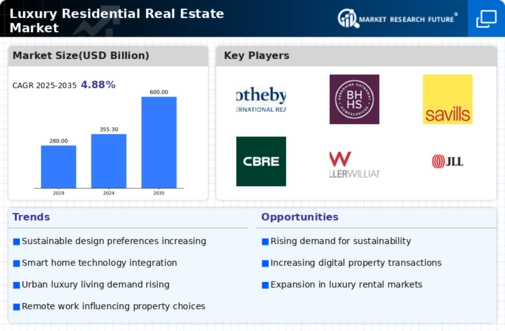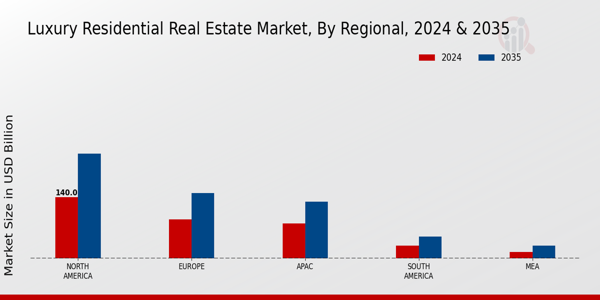Urbanization and Migration Trends
Urbanization continues to be a significant driver of the Global Luxury Residential Real Estate Market Industry. As more people migrate to urban centers in search of better opportunities, the demand for luxury housing in metropolitan areas increases. This trend is particularly pronounced in cities like New York, London, and Hong Kong, where luxury properties are highly sought after. The influx of affluent individuals into these urban environments is likely to sustain the market's growth, as evidenced by the projected market value of 600 USD Billion by 2035. Urbanization not only enhances the desirability of luxury properties but also contributes to the overall economic vitality of these regions.
Increasing Affluence of Global Population
The Global Luxury Residential Real Estate Market Industry is experiencing a notable surge due to the increasing affluence of the global population. As wealth distribution becomes more concentrated, a growing number of individuals are entering the high-net-worth category. In 2024, the market is valued at approximately 355.3 USD Billion, reflecting the demand for luxury properties. This trend is particularly evident in emerging economies where rising disposable incomes are enabling more consumers to invest in high-end real estate. The expansion of the affluent class is likely to drive the market further, suggesting a robust growth trajectory in the coming years.
Technological Advancements in Real Estate
Technological advancements are reshaping the Global Luxury Residential Real Estate Market Industry, enhancing the buying and selling experience for consumers. Innovations such as virtual reality tours, blockchain for secure transactions, and AI-driven property management are becoming increasingly prevalent. These technologies not only streamline processes but also provide potential buyers with immersive experiences that elevate their engagement with luxury properties. As the market adapts to these advancements, it is likely to attract a tech-savvy clientele, further driving growth. The integration of technology into luxury real estate is expected to contribute to the market's projected CAGR of 4.88% from 2025 to 2035.
Sustainability and Eco-Friendly Developments
Sustainability is emerging as a pivotal driver within the Global Luxury Residential Real Estate Market Industry. As environmental concerns gain prominence, luxury buyers are increasingly seeking eco-friendly properties that incorporate sustainable practices. Developments featuring energy-efficient designs, renewable energy sources, and sustainable materials are becoming more desirable. This shift aligns with the broader global movement towards sustainability, potentially enhancing property values and attracting discerning buyers. The market's evolution towards greener solutions may play a crucial role in its growth, as consumers prioritize environmental responsibility alongside luxury, thereby influencing future investment trends.
Global Economic Stability and Investment Trends
The Global Luxury Residential Real Estate Market Industry is closely tied to global economic stability and investment trends. As economies stabilize and grow, high-net-worth individuals are more inclined to invest in luxury properties, viewing them as secure assets. The market's current valuation of 355.3 USD Billion in 2024 indicates a strong foundation, while the anticipated growth to 600 USD Billion by 2035 underscores the potential for continued investment. Factors such as low-interest rates and favorable lending conditions further enhance the attractiveness of luxury real estate as an investment vehicle. This interplay between economic conditions and luxury property investment is likely to shape the market's trajectory.






















Leave a Comment